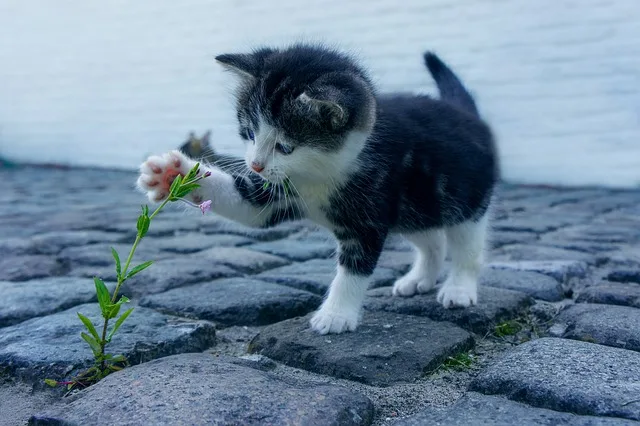In the world of sales and marketing, curiosity is a powerful tool that can be harnessed to engage customers and drive sales. This technique, known as curiosity selling or curiosity marketing, involves piquing the interest of potential customers by creating a sense of intrigue and mystery around your product or service.
Disclosure: If you click on my affiliate/advertiser’s links, I am going to receive a tiny commission. AND… Most of the time, you will receive an offer of some kind. It’ s a Win/Win!
Understanding the Curiosity Selling Technique and Its Benefits
Curiosity selling is not about providing all the answers upfront; instead, it focuses on stimulating questions and leaving customers wanting more. By using techniques such as discovery questions, the “cliffhanger” technique, and stimulating questions, you can tap into the power of curiosity to captivate your audience and increase their desire to learn more about what you have to offer.

Image by Dim Hou from Pixabay
The benefits of incorporating curiosity selling into your sales strategy are numerous. Firstly, it helps to create a deeper level of customer engagement. When customers are curious about something, they are more likely to actively seek out information and become invested in the buying process.
Secondly, curiosity selling allows you to stand out from competitors by offering a unique approach that captures attention. In a crowded marketplace where consumers are bombarded with information, using curiosity as a sales tactic can help you cut through the noise and make a lasting impression.
Lastly, understanding the science behind curiosity can give you valuable insights into consumer behaviour. Studies have shown that when we experience curiosity, our brains release dopamine – a neurotransmitter associated with pleasure and reward. By leveraging this natural response in your sales efforts, you can create positive associations with your brand and increase the likelihood of conversion.
In this post on curiosity selling technique and its benefits, we will delve deeper into how this approach works and explore real-world examples of its successful implementation. So, let’s dive in and uncover how harnessing the power of curiosity can take your sales strategies to new heights.

Why Curiosity is a Powerful Tool in Sales and Marketing
Curiosity is a powerful tool in sales and marketing, as it has the ability to captivate and engage potential customers. By leveraging curiosity, businesses can create a compelling marketing strategy that drives interest and ultimately leads to higher conversion rates.
The psychology of curiosity plays a significant role in the success of curiosity-based marketing strategies. When individuals are curious about something, their brain chemistry changes. The release of dopamine, a neurotransmitter associated with pleasure and reward, occurs when we encounter something new or unexpected. This chemical reaction creates a sense of anticipation and motivates individuals to seek out more information.
In sales, curiosity can be used strategically to create cognitive dissonance – a state of mental discomfort that arises when there is an inconsistency between beliefs or behaviours. By piquing curiosity through thought-provoking questions or intriguing statements, sales professionals can create this cognitive dissonance and prompt potential customers to reevaluate their current beliefs or decisions.
Businesses that embrace curiosity as part of their selling approach tend to be higher-performing and more adaptable. Curiosity-driven salespeople are constantly seeking new knowledge, exploring different perspectives, and adapting their strategies based on customer feedback. This flexibility allows them to better understand customer needs and tailor their offerings accordingly.
Furthermore, incorporating curiosity into marketing campaigns can lead to increased brand engagement. By creating content that sparks curiosity and leaves audiences wanting more, businesses can foster deeper connections with consumers who actively seek out additional information about products or services.
We see then that, harnessing the power of curiosity in sales and marketing can yield numerous benefits for businesses. From stimulating brain chemistry to creating cognitive dissonance and fostering adaptability, embracing curiosity as a strategic tool can lead to higher-performing firms with increased brand engagement and improved conversion rates.
How to Implement the Curiosity Selling Technique in Your Sales Process
Implementing the curiosity selling technique can greatly enhance your sales process and help you engage potential customers on a deeper level. By leveraging curiosity, you can create a sense of intrigue and captivate your audience, making them more receptive to your sales message.
- Create compelling headlines: Grab your customers’ attention with intriguing headlines that make them curious about your product or service.
- Pose thought-provoking questions: Ask questions that pique your customers’ interest and make them curious to learn more.
- Tell captivating stories: Share stories that create anticipation and leave your customers wanting to know what happens next.
- Use teaser campaigns: Release teasers or sneak peeks of upcoming products or offers to generate excitement and curiosity among your target audience.
- Create knowledge gaps: Provide valuable information but leave out crucial details, encouraging customers to seek more information from you.
One effective way to implement this technique is by creating compelling headlines that pique the curiosity of your target audience. A well-crafted headline can grab attention and entice readers to learn more about what you have to offer.
Send better emails, get better results
Consider using thought-provoking questions into your sales pitch. By asking questions that challenge conventional thinking or highlight potential pain points, you can stimulate curiosity and encourage prospects to explore how your product or service can solve their problems or meet their needs.
Storytelling is another powerful tool for curiosity selling. By weaving narratives that resonate with your target audience, you can evoke emotions and spark imagination – create a sense of anticipation and keep prospects engaged throughout the sales process.
Teaser campaigns are also effective in generating customer engagement through curiosity. By releasing snippets or hints about an upcoming product or promotion, you can build anticipation and generate buzz among your target audience.
Creating irresistible offers is essential in curiosity selling. By combining intrigue and clarity in your offers, you can spark curiosity while clearly communicating the value proposition of your product or service. This helps potential customers understand why they should choose you over competitors.
Testing different approaches will help you master the art of curiosity selling. Experiment with various techniques such as different headlines, storytelling styles, or teaser campaign strategies to see what resonates best with your target audience. Analyse the results and refine your approach accordingly.
Incorporating the curiosity selling technique into your sales process requires careful planning and execution. However, when done effectively, it can significantly increase customer engagement, boost conversions, and ultimately drive business success.
Examples of Successful Curiosity-Based Sales Campaigns
Curiosity-driven marketing campaigns have proven to be highly effective in capturing the attention and interest of consumers. By leveraging the power of curiosity, brands are able to create engaging and memorable experiences that drive sales. In this section, we will explore some successful examples of curiosity-based sales campaigns.
One notable example is the “Mystery Box” campaign by online retailer FabFitFun. They created a limited-edition mystery box filled with a curated selection of products from their subscription service. The catch? Customers had no idea what specific items were included in the box until it arrived at their doorstep. This created a sense of anticipation and intrigue, driving customers to make a purchase in order to satisfy their curiosity.
Another successful case study is the “Unlock Your Inner Artist” campaign by makeup brand Sephora. They launched an interactive online quiz that asked participants questions about their personality and preferences. At the end of the quiz, participants were given personalized product recommendations based on their answers. This not only piqued curiosity but also provided customers with a tailored shopping experience, increasing the likelihood of conversion.
The key to these successful campaigns lies in creating an element of mystery or surprise that compels consumers to take action. By tapping into human psychology and our innate desire for discovery, brands can effectively engage with their target audience and drive sales through curiosity-based marketing techniques.
One notable example of utilising this marketing technique successfully is Barry Rhein, a renowned sales trainer and consultant. Rhein has developed a unique approach to selling based on curiosity. He encourages sales professionals to ask thought-provoking questions that pique the curiosity of potential customers, leading them to actively seek out more information about a product or service.
Another success story comes from Kristi Faltorusso, a marketing strategist who specializes in curiosity-driven campaigns. Faltorusso has worked with various brands to create captivating experiences that tap into consumers’ natural sense of curiosity. By creating mystery and intrigue around their products or services, these brands were able to generate buzz and drive sales.
These few case studies highlight the effectiveness of curiosity-driven marketing campaigns. These examples also provide valuable insights into how businesses can harness the power of curiosity to create compelling sales experiences and achieve their marketing goals.
The Dos and Don’ts of Using Curiosity in Sales Conversations
When it comes to using curiosity in sales conversations, there are certain dos and don’ts that should be followed to ensure an ethical and effective approach. Curiosity can be a powerful tool in engaging potential customers and driving sales, but it must be used responsibly to maintain trust in the sales process.
Dos:
- Create a sense of mystery around your product or service.
- Ask thought-provoking questions to pique curiosity.
- Provide teasers or hints about the benefits customers can expect.
- Use curiosity as a hook to keep customers engaged throughout the sales process.
- Don’ts:
- Avoid misleading or false claims that may disappoint customers.
- Don’t overuse curiosity, as it may come across as gimmicky or manipulative.
- Avoid creating excessive suspense that frustrates potential buyers.
One of the key dos of curiosity selling is to use it as a means of creating genuine interest and engagement. By asking thought-provoking questions or sharing intriguing information, you can pique the curiosity of your prospects and encourage them to actively participate in the conversation.
Another important aspect is maintaining transparency and honesty. While curiosity can be used to create intrigue, it should never be used as a manipulative tactic. Always provide accurate information about your product or service, ensuring that your claims are backed by evidence.
On the other hand, there are certain don’ts that should be avoided when using curiosity in sales conversations. Firstly, do not use false or misleading statements solely for the purpose of generating interest. This can damage your reputation and erode trust with potential customers.
Additionally, avoid crossing boundaries or invading privacy when attempting to spark curiosity. Respect personal boundaries and ensure that any information shared is relevant and appropriate within the context of the sales conversation.
In summary, using curiosity in sales conversations can be highly effective if done ethically (more of this in the next section). By following these dos and don’ts, you can harness the power of curiosity while maintaining trust with your prospects throughout the sales process.
The Ethical Considerations of Using Curiosity in Sales
When it comes to sales, curiosity can be a powerful tool. It can pique the interest of potential customers and drive them to learn more about a product or service. However, as with many other selling tactics, there are ethical considerations that need to be taken into account when using curiosity in sales techniques.
One of the key principles in ethical selling practices is transparency and trustworthiness. It is important for sales professionals to ensure that their use of curiosity does not cross the line into manipulation. Customers should feel empowered and informed throughout the sales process, rather than being coerced or deceived.
Maintaining trust is crucial in any sales relationship. If customers feel that their curiosity is being exploited or manipulated for the sole purpose of making a sale, it can damage the trust they have in the salesperson and the company as a whole.
To ensure ethical use of curiosity in sales, it is important for sales professionals to strike a balance between generating interest and providing honest information. They should focus on educating customers about the benefits and features of a product or service, rather than resorting to manipulative tactics.
By adopting an ethical approach to using curiosity in sales, businesses can build long-term relationships with their customers based on trust and mutual respect. This not only leads to customer satisfaction but also enhances brand reputation and loyalty.
Conclusion: Harnessing the Power of Curiosity for Sales Success
In conclusion, harnessing the power of curiosity can greatly contribute to sales success. By adopting a curiosity-driven sales approach, sales professionals can increase their chances of closing deals and building lasting customer relationships.
Using curiosity as a tool in the sales process allows for a more engaging and interactive experience with potential customers. By piquing their interest and creating intrigue, sales professionals can capture attention and hold it throughout the entire sales conversation.
Closing deals with intrigue involves asking thought-provoking questions, presenting unique solutions, and providing valuable insights that leave customers wanting to learn more. This approach not only helps in sealing the deal but also establishes trust and credibility with customers.
Furthermore, by continuously nurturing curiosity throughout the customer journey, sales professionals can build lasting relationships with their clients. This involves staying curious about their needs, challenges, and goals even after the sale is made. By doing so, they can provide ongoing support and offer additional products or services that align with their customers’ evolving needs.






